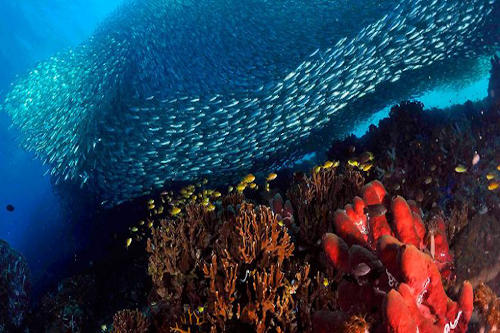Tubbataha Reefs - Philippines - Only by Liveaboard!
North Atoll and South Atoll

Tubbataha Reefs Natural Park is a marine protected area and world-renowned scuba diving site. It is home to more than 1,200 marine species, including sea grasses and algae, corals, sharks, rays, fishes, sea turtles, seabirds and marine mammals. The Park is an exceptionally healthy reef ecosystem and its strong no-take level protections ensure this biodiversity stays safe.
Tubbataha Reefs Natural Park is an important asset for global conservation, as 181 of the species found there are threatened to some degree, from Vulnerable to Critically Endangered. Tubbataha is made up of two atolls dense with biodiversity that serve as nesting grounds for endangered turtles and more than 100 species of birds. It is a breeding and rookery ground for many species of migratory and resident seabirds, including the Critically Endangered Christmas Island frigatebird, as well as the Endangered green sea turtles and Critically Endangered hawksbill sea turtle.
Because it’s so far from land, Tubbataha only started to feel the effects of human exploitation in the 1980’s. Recognizing its great biodiversity value, the government of the Philippines first protected the area through legislation in 1988. Protective regulations have only been strengthened since then, leading to international recognition including its Platinum Blue Park award. This UNESCO World Heritage Site might be your best bet to see whale sharks, manta rays, hawksbill turtles, hammerheads, spinner dolphins and schooling gray reef sharks all in one day.
Diver’s Notes
Average Water Temperature: 25° C to 29° C / 78°-85° F
Visibility: 12-36 meters / 40-120 feet
Seasonal Access Only: March thru June
Liveaboards we offer: Seadoors, Philippine Siren, Infiniti, Atlantis Azores, Solitude One.
Five Popular Dive Sites
· Amos Rock, also known as Southwest Rock, is one of the popular scuba dive sites found on the North Atoll of. It features a breathtaking wall that is covered in a variety of corals, including whip corals, and you will also find massive gorgonian fans along it as well. A variety of large fish, including groupers, snappers, mackerels, and even Napoleon wrasses are also found drifting in the currents of this dive site. During a dive, you may encounter sharks, such as grey reef sharks and white-tip reef sharks, often seen in this area.
· Shark Airport, found on the North Atoll, is one of the best places for spotting a variety of marine life. Endangered sea turtles can be seen here, along with white-tip reef sharks and plenty of different corals. This relatively shallow site is also popular for night dives, during which you may get the chance to see eels, different types of pufferfish, and other nocturnal creatures.
· Black Rock is a dive site found on the South Atoll. You can follow the steep wall and see what marine life you encounter, but this site is not really known for its corals. Instead, you can wait for the sharks, particularly the white-tip reef sharks, to come out, as well as manta rays and the huge Napoleon wrasses.
· Washing Machine is named for the unpredictable currents which sometimes change direction in the middle of a dive, the Washing Machine is located at the exposed northeastern edge of Tubbataha. Known for having some of the best visibility of any dive site within the Marine Park, this dive site is home to grey reef sharks and an amazing diversity of tropical coral reef fish.
· Bird Island is a very popular site that is also located on the North Atoll. There is something for everyone here, from crevices and swim-throughs to explore, as well as a steep wall with overhangs that may be home to a variety of marine animals. Strong currents occur in certain spots, so beginner scuba divers may want to only stay in certain areas of the site or avoid it altogether. An advanced open water certificate is usually required for this site. The reef is home to a variety of different types of colorful corals, and you will more than likely find a tranquil shark resting on the sandy bottom of this breathtaking site. Eels and rays are also common here. If you get lucky, you may even see a giant ray swimming by.